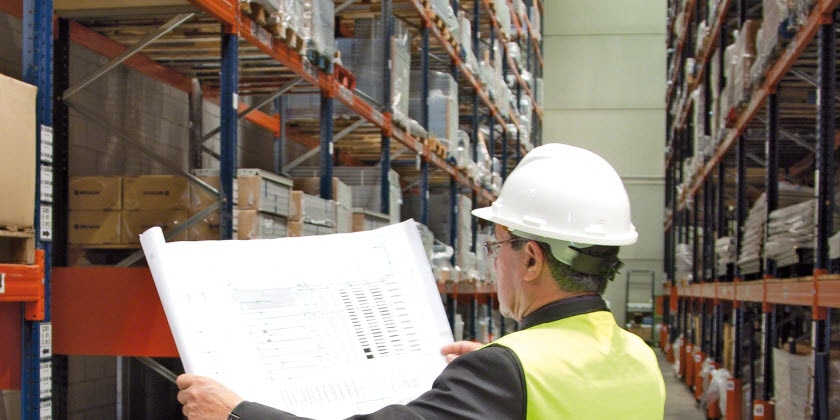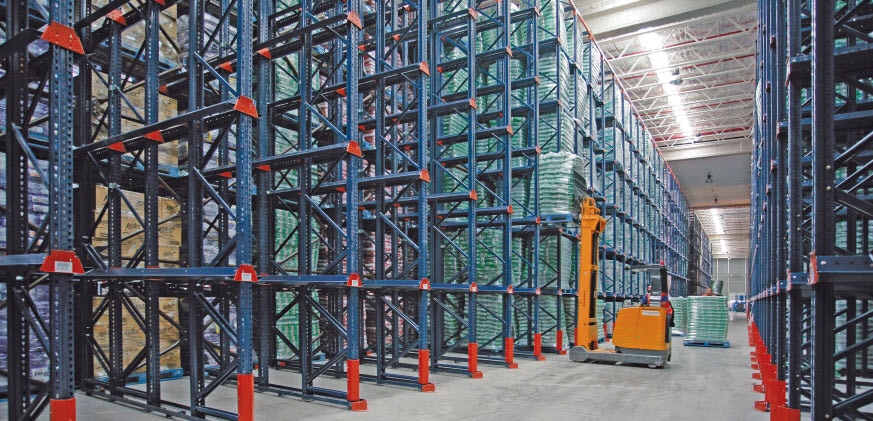Despite its obvious importance, there are still many questions about the essential measures the storage systems user should observe when minimising the risk of accidents in daily operations. Protecting personnel and ensuring proper warehouse operations should be any logistics manager’s top priority. In this article, Mecalux shares its expertise on this topic, analysing the keys to good management in safety policy.
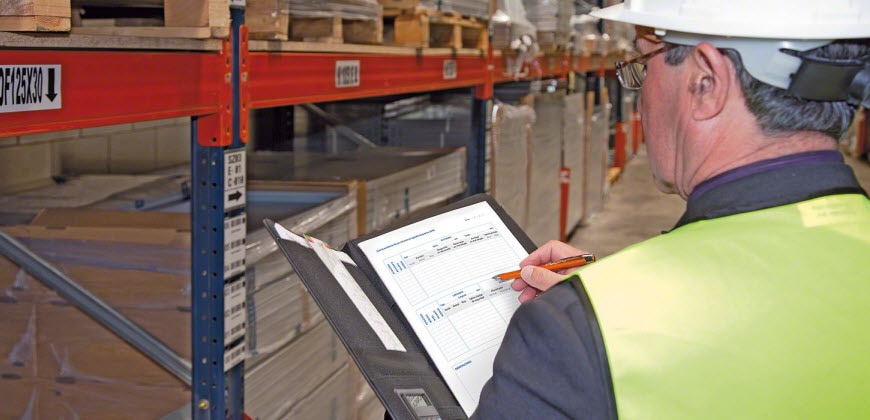
The safe warehouse
What is meant by safety in the warehouse is the set of recommendations and measures taken to ensure the optimum state of the components included in it and to prevent risks to people, service disruptions or damage to the goods.
The interaction between operators and forklifts or other handling equipment is liable to cause accidents and damage to the storage structures.
To ensure maximum protection and minimise any risk, there are five key points to consider: training, prevention, responsibility, maintenance and technical inspection.
Training
Involving and motivating all company personnel to take the right steps in managing occupational health and safety in the workplace should be one of the primary objectives of the management of a company.
In this sense, Mecalux advocates the need for training as an indispensable preventative measure, providing courses to users of the installation about the safe and efficient use of equipment, and providing safety manuals for each of the products of the facility.
The racks are designed to withstand the stipulated loads, complying with the European standards on calculation and use. The vast majority of accidents are caused by direct impacts of handling equipment, especially to the outer uprights of the frames. Depending on the force of the blow, the racking can immediately collapse or remain in place for a while, but with less strength capacity. Now, if some vital element deteriorates, such as an upright, and you do not act immediately, the rack can collapse from another blow or a pushing force in the same point or to another nearby.
For this reason, it is crucial that operators be adequately trained and mentally prepared for the proper use of the equipment and report any damage that occurs to the racks to those in charge, so that what must be done is evaluated.

Training is an investment in the future, both in human costs and economically
Prevention
Risk assessment is the cornerstone of the prevention of occupational accidents. If this step is not carried out, it will be very difficult to determine and take appropriate measures.
Proper management in this area unavoidably involves the observation of five steps:
- Identification of risks and the exposed operators.
- Risk assessment and prioritisation of the same.
- Planning the necessary preventive measures.
- Adoption of such measures.
- Monitoring and review.
First and foremost, the user company is obliged to provide their personnel with completely safe installations, with the appropriate equipment and in good condition.
In a warehouse, it is essential to check not only the state of the racks and forklifts but also that there is adequate lighting, that the pallets are in good condition and withstand the load, that the working aisles are clean and tidy, etc.
With respect to the racking, these have been calculated based on the specifications provided to the manufacturer by the user or buyer. Therefore, the distribution of levels, profile models and the strength of the various components are the result of precise calculations, which also comply with European standards.
Therefore, damage or changes in its distribution or usage lower the safety coefficients considered in the design and reduce the load capacity.
Regarding handling equipment, it is evident that they deteriorate with use: the moving parts and wheels wear out, improper clearances develop, they can lose fluids that increase the risk of slippage, etc.
Since this influences the behaviour of equipment, to work with greater safety, preventative maintenance is fundamental and also not using machines that are in bad condition.
The assembly of racking in the installation must be performed by qualified personnel as per the specific regulations regarding design and according to the requirements applied by the manufacturer for its safe usage
Liability
The European standard EN 15635 explicitly specifies what responsibilities should be taken on by both the racking or storage system supplier and the user. Herein, we will discuss only the basics of safety:
Responsibilities of the racking supplier
- Carry out the distribution and calculations based on the specifications provided by the customer.
- Define the technical limitations of the system.
- Advise what additional racking protection must be provided.
- Define the loads supported by the warehouse floor due to storage equipment.
- Provide safe load warning notices of the facility, which should be placed in different visible locations and indicate the distribution of levels and the maximum load capacity of the racks. These cannot be altered without the prior consent of the manufacturer.
Responsibility of the racking user
- Establish safe working conditions based on a risk assessment, which minimises the chances of damage to people and the storage equipment.
- Appoint a person responsible for overseeing the daily safety of workers and storage equipment, the PRSES (Person Responsible for Storage Equipment Safety).
- Guarantee that the personnel handling the equipment have the appropriate training and perform manoeuvres correctly.
- Ensure that operations coincide with the instructions from the racking provider.
- Avoid or reduce the number of incidents by placing the appropriate signalling and security measures (enclosures, mesh, and protection, etc.).
- Conduct regular inspections of the racks.
- Keep storage equipment in good working order at all times in accordance with regulations.
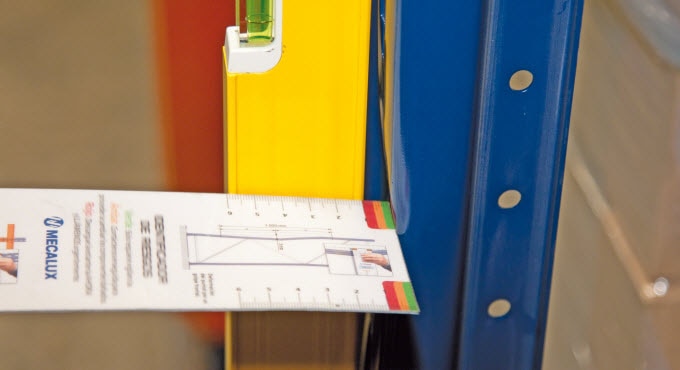
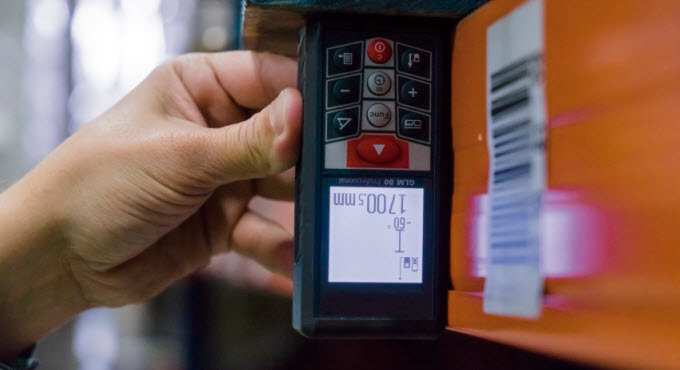
Maintenance
Routine maintenance, control, and monitoring are factors that will positively influence the safety and good condition of the installation.
Mecalux recommends a periodic plan of inspections, as indicated by the EN 15635 standard, for detecting, recording and reporting anomalies, adapted to each warehouse, and taking into account their specific conditions.
When the turnover of goods and the hours worked in the warehouse are very high, the inspection plan must be exhaustive:
- Daily visual inspection by warehouse personnel to detect easily visible anomalies and, accordingly, proceed with its immediate replacement.
- Weekly inspection by the PRSES, in which the verticality of the structure will be verified and all components of the lower levels with notification, qualification and reporting of damage.
- Monthly inspections by the PRSES, which also include general aspects such as the orderliness and cleanliness of the warehouse; with notification, qualification, and reporting of damage.
To perform routine checks, it is advisable that the user has the collaboration of the storage systems provider, because they know its characteristics best, drawn from the calculations made, the profiles used and the strengths.
This joint effort between the two parties reflects best practices within facilities.
The safe and rational use of an installation are achieved through user collaboration with the manufacturer or supplier of the racking and handling equipment

Replacement of damaged components
Generally, damaged elements result in a loss in its strength capacity to a greater or lesser extent.
People trained to detect the risk of damaged components know what to measure and how to figure out its condition, based on three levels of risk that are identified by adhesive labels of three colours: green, amber and red.
The components marked as red are considered in critical condition, for immediate action. If the damaged element is a beam, the entire level must be unloaded, and if it is a frame, the two adjacent bays.
The locations have to be disabled until the damaged components are replaced by others with similar characteristics and in good condition.
The amber level does not require immediate unloading of the locations, but action must be taken as soon as possible.
It is necessary that once the deteriorated level or levels are unloaded, they are not reloaded again until the damaged component is replaced by a new one.
The user must have a means of cutting off access to the racks in poor condition and prevent their use.
Finally, the elements marked in green are considered suitable because the buckling does not exceed the loss limit of the load capacity.
Components are safe for use but require examination and evaluation in future inspections to re-check their condition.
The EN 15635 standard, Mecalux advises replacing the damaged materials, mainly those marked with the colour red, rather than repair them. Some countries require the replacement of all damaged components.
The reason is that the quality control of repaired materials is very complex; there is no physical evidence showing that they possess the same properties as the originals.
One must be careful with those companies that set out to re-shape the profiles via elements that exert pressure on them so that, in theory, they return to their original state: the mere fact of folding the profile sheet with this method results in the reduction of its strength.

Technical inspection
The EN 15635 standard requires the owner of the warehouse to conduct an annual inspection of the metal racking by a qualified technician, to assess the condition of all elements of the installation. It constitutes an in-depth look of all indications in the standard, taking into account key issues such as the:
- General condition of racks.
- Good conditions and suitability of pallets.
- Correlation of the installation’s storage levels with those indicated in the contract’s layout.
- Appropriateness of forklifts and unit loads for the racking.
- If safe load warning notices are visibility located.
- If manoeuvres are performed correctly by operators.
- If aisles are kept clean and in good order.
- If upright protectors exist or are needed.
- Cracks, subsidence or possible defects in the floor.
- Tolerances and buckling of the racking, which does not exceed certain limits.
- Tagging of elements in poor condition or disrepair.
- Notification of possible risks in the installation, and the prospective need to immediately unload bays and levels.
The expert, starting with the analysis performed, will issue a report detailing the condition of the installation and, if the facility fails to comply, specify the actions to be taken.
A brief review of the current legislation in Europe
Below it deals briefly with the various standards that must be observed and which are referred to throughout this article.
EN 15512: Principles for structural design
This standard is the general European directive related to the design of steel structures, adapted to pallet racking. It includes guidelines on the calculation, process and tolerances for assembly needed by manufacturers and suppliers.
EN 15620: Tolerances, buckling, and clearances
This standard provides for different variables in the storage systems. They give guidelines to be followed by the user and the supplier, depending on the material handling equipment available in the warehouse:
- Tolerances for the floor and the assembly of racks.
- The maximum buckling of the profiles used.
- Clearances that locations must have.
EN 15629: Specification of storage equipment
This standard indicates which data the customer must be provided to the storage systems manufacturer for the calculation of the racks. These include the:
- Unit loads (measured with and without goods, construction characteristics and weight).
- Handling equipment to be used.
- Characteristics of the premise, including the strength of the floor.
- Specific data that the user considers to be significant.
Subsequently, in the quote, the customer must verify that the supplier has distributed and calculated the racks according to their specifications.
EN 15635: Application and maintenance of storage equipment
Based on the assumption that all previous standards were fulfilled, therefore, installed racks are safe and suitable for use with the appropriate clearances to carry unit loads which were calculated. The EN 15635 is intended to minimise risks in the warehouse and prevent damage to the storage structures.
According to this standard, the user is primarily responsible for the safety of the persons working in the installation and in ensuring the proper condition of the storage systems.
To achieve this objective, the responsibilities mentioned above should be taken into account.
UNE 58014: Steel static storage systems: Validation of storage equipment
This standard, only applicable in Spain, establishes the process to validate storage equipment and indicates which documents the supplier must give to the user:
- A certificate with the formal validation, i.e., that the installation has been duly calculated.
- Validation that the assembly has been correctly performed.
- Document validation of what has been installed and its strength characteristics.
Mecalux: 30 years providing warehouse safety
For Mecalux, collaboration between the user and the storage systems manufacturer must be continuous and kept up after delivery.
Therefore, we offer our customers the following services:
- Routine revisions and inspections, according to your needs.
- Consultancy on any question about the modifications that are desired to be applied (please remember that the layout or use of storage equipment cannot be altered without the consent of the user).
- Supply of the components required to replace those that are damaged.
- Performing possible modifications and repairs correctly by an assembly team trained in the particular assembly of the supplied racking.
- Provision of safety manuals as a reference for warehouses users and managers.
- Maintaining a record of inspections and the maintenance work carried out.
- Technical guidance on the utilisation and safety of the racks in the warehouse.
- 24-hour telephone helpline.
As a manufacturer with more than 50 years of experience, Mecalux is in the best position to inspect and issue certificates for racks. In addition, its business practices worldwide, with a presence in over 70 countries, gives it a global perspective on the standards applied in different countries in regards to occupational health and safety.
The technical inspection by Mecalux is a simple process, which gives customers the following advantages:
- Inspection certificate signed and stamped by Mecalux.
- Documented report that reflects the results of the inspection, the observations, and the proposals for possible actions to carry out.
- Identification of risks using stickers placed on damage found on racks.
- Updating the safe load warning notice, indicating that the annual technical inspection is passed, and specifying the date of the next review.
- Investigation of incidents.
If you have not yet had a mandatory annual technical inspection performed, we recommend that it be put at the top of your ‘to-do’ list, thereby fulfilling the responsibility of ensuring the health of the operators at your storage facility.
FAQs
What factors can affect the safety of the warehouse?
- Forklift malfunction.
- The quality of operator training.
- Changes in the original handling equipment.
- Handling equipment in poor condition.
- Changes in the type or quality of the pallets originally used.
- Damaged storage elements.
- Load overhang in relation to the goods storage elements.
- Deficient clearances.
- Aisle width is too narrow.
- Poor cleanliness and orderliness.
- Insufficient lighting.
- Floor defects.
Why is proper maintenance essential in a warehouse?
All components in the warehouse must be in optimal condition to minimise the risk of accidents.
Periodic inspections and maintenance are critical to validate the condition of storage systems and ensure the safety of equipment and personnel.
The frequency with which they are performed depends on the characteristics of each installation and the standards in vigour./p>
Which racks are subject to revision?
According to the EN 15635 standard, all racks where the use of forklifts or other handling equipment is involved:
- Pallet racking.
- Cantilever racking.
- Drive-in pallet racking.
- Live pallet racking.
- Pallet Shuttle system.
- Push-back racks.
- Mezzanines where handling equipment is used.
- Automated warehouses with stacker crane.
- Clad-rack warehouses
Should we wait for the annual technical inspection to check the condition of the warehouse?
Obviously not. Periodic preventive revisions are equally important and necessary because they guarantee the safety of the installation at all times, thereby exceeding the technical inspection required by the standard and obtaining the certificate.
When should the technical inspection by an expert be performed?
According to the EN 15635 standard, racks should be inspected by an expert once a year (with intervals not to exceed 12 months).
Who carries out the technical inspection?
Qualified personnel, who have the information and know-how to detect and evaluate damaged elements, and how to make the appropriate decisions
The technical team of the storage systems manufacturer or supplier is the most suited to carry out technical inspections since they know the characteristics of the racks that have been installed, the calculations that have been made, the profiles used and their strengths.
Will the inspection affect daily warehouse operations?
The rigorous inspection that Mecalux technicians perform causes minimal interference with the normal operations of the facility.
Why trust Mecalux?
With over 30 years of experience in conducting inspections of storage equipment, Mecalux has the knowledge and essential resources for reliable, quality inspections.
How do I request an inspection of my warehouse?
Get in touch with Mecalux to book your inspection with one of our experts.

